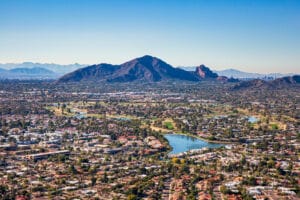As Arizona traffic fatalities escalate, traffic safety experts are calling for action to address the underlying causes and enhance road safety.
MORE NEWS: 3 Metro Phoenix cities among 25 earliest commute times in U.S.
The Arizona Department of Transportation reported a 28.3% increase in fatal traffic crashes from 2018 to 2022 in its annual Motor Vehicle Crash Facts report. The traffic fatality total in 2022 ranked as the state’s second-highest on record, marking a continuous rise in fatalities each year since 2019.
Doug Pacey, Assistant Communications Director for Digital Communications at ADOT, explained the parameters of the fatal traffic crashes included in ADOT’s data reports.
“A fatal crash is any crash that involves a vehicle and results in a human death. A fatal crash can involve one vehicle, multiple vehicles, a vehicle and pedestrian or a vehicle and a bicyclist, for example,” said Pacey.
Experts attribute this significant rise in fatalities to a number of factors, with COVID-19 emerging as a prominent contributor.Top of Form
Steven Polzin, an expert in transportation planning and policy, said COVID-19 had an impact on safety trends, noting an abrupt shift during the pandemic.
“As we got into COVID-19, it was very apparent early on that safety trends had changed pretty markedly. In general, safety changes slowly in terms of the fatality rates, and the accident rates and are generally predictable over time. But all of a sudden, we were seeing some pronounced changes,” Polzin said.
Polzin said the pandemic-induced confinement could have led to an increase in crashes.
“When there’s less congestion, people are driving faster, and that contributes to higher fatality rates,” Polzin said. “People wanted to get out of the house, and when they got out of the house and got in the car, they let loose, driving more carelessly”.
Ed Taube, the lead trainer at the Arizona Chapter National Safety Council, said another contributing factor was reduced police enforcement on the roads during the pandemic.
“Enforcement went down because, during COVID-19, officers didn’t want to interact with people and stopped pulling them over,” Taube said. “If you recall, at the same time, there were some societal issues regarding policing. That’s when we had the George Floyd protests, and there was a lot of social upheaval around policing”.
Taube said this decrease in police enforcement is still prevalent today, with the City of Phoenix currently facing a shortage of over 500 officers, according to reporting by AZ Big Media.
“The City of Phoenix had a lot of retirements and they have a hard time recruiting new officers. A lot of this shows up in less traffic enforcement. If we had more officers on the street enforcing traffic laws and people were concerned about getting tickets again, it would have an effect,” Taube said.
As advancements in automotive technology continue, Polzin said there are potential risks associated with increased safety features.
“There are some behavioralists that worry as we get safer cars, people will offset it by driving risky or counting on their car to be safe,” Polzin said.
The ACNSC is one initiative in the state working to combat the increase in traffic deaths through various programs, including ticket dismissal and defensive driving classes mandated by the Motor Vehicle Division. These classes educate participants on traffic laws and highlight safe driving practices.
Taube emphasized common factors contributing to Arizona traffic fatalities, advocating for practices to combat the rise of traffic deaths in the future.
“The most common factors contributing to traffic crashes are driving too fast and following too closely. I teach people, that if you simply slow down and add more space, about half the crashes will go away. It’s really that simple,” Taube said.




